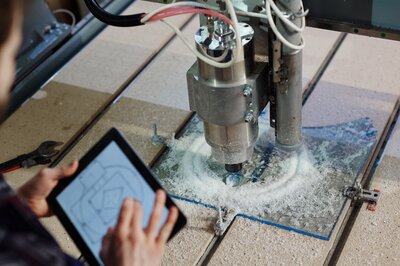Eight benefits of a digital manufacturing ecosystem
ERP surfaced in the 1960s as a system for inventory management and control. It became more popular in the 1970s due to material planning, manufacturing, and data collection. Now, advances in information technology allow ERP software to collect, classify and analyze real-time data from different departments at once.
ERP software is more integrated than ever
The most common systems employed in manufacturing include:
- Enterprise resource planning (ERP): software focused on integrating diverse computer systems to centralize information.
- Manufacturing execution system (MES): ensures execution of operations by tracking production through its life cycle.
- Quality management system (QMS): controls the output to meet regulatory and customer requirements.
- Computerized maintenance management system (CMMS): Database of maintenance and calibration operations within a business.
- Tool crib management system: Controls stock, tool availability, condition and life cycle.
- Learning management system (LMS): Software containing education resources, tracking, documentation, and delivery of training materials.
- Business intelligence (BI): Technologies and applications gathering data for documentation, analysis, and presentation for decision-making.
Every manufacturing company needs systems to fulfill these functions. There are quality, production, lead times, tools, regulations, and customers to please, and integrating these systems makes life easier in the shop. Companies have a need for an all-in-one solution, which can be achieved by using a digital manufacturing ecosystem (DME).
Fragmented business intelligence was common in the old days. Every department had its own workflow, without taking into account the problems or efficiencies achieved in other locations of the shop. Fortunately, DME software aims for the integration of the whole company, which is the cornerstone of the eight benefits we cover below.
1. Simplifies and improves compliance
Tracking made easy. Digital quality manuals build processes to help with on-time delivery, internal quality, supplier performance, customer perception, and customer returns. These systems are safer than paper-based methods. Theft, natural disasters, and human mistakes affect the generational conservation of intelligence. Paperless systems became popular because they're cloud-based. Previous revisions can be easily recovered, and new revisions and approvals are quick and easy.
2. Reduces machine downtime
Visual work instructions, including photos and video, will cut setup times leading to efficient and accurate scheduling of operations and work orders. DME software integrates with CNC machines to save time on calibration and maintenance. Digital shopping carts ensure you order the right tools for the jobs ahead of time, reducing the likelihood of machine downtime.
Find out the top benefits of manufacturing ERP with our free guide
3. Makes producing quotes easier
Estimating and quoting modules allow shops to generate quotes faster with ready-made templates. Customer issued RFQs and quotes are ready to go. Here’s how estimates can seamlessly turn into work orders.

4. Reduces scrap parts and improves quality control
Paperless systems reduce human error. They automatically issue NCRs, CARs and PARs to maintain quality control. Every mistake and best practice is traceable to improve performance.
5. Increases output while lowering manufacturing costs
Job-costing and company-wide data facilitate tracking benchmark run-times to address inefficiencies, which results in better control of the business. You’ll stop wasting resources on transitions, human mistakes and machine downtime due to the real-time reports the ERP system generates.
6. Optimizes tooling availability, performance, and lifespan
Rotating tool assembly features make standardization and cutting tool management easy. Integrating work cell modules alert users if an RTA is out-of-tolerance on offline pre-setters. Additionally, paperless software allows tracking of fixtures, consumable tooling, equipment, and materials.
7. Saves time transitioning between tasks
In a DME, every record is seamlessly linked to all related information in other modules and reports. Finding the information you need is fast and easy, and dashboards allow efficient workflow on the right priorities. When customers send you purchase orders from a previous quotation, you can turn it into a customer PO with one click.
8. Organizes communication and boosts productivity
Multiple team members can communicate, share files and access the latest revisions in real-time. They can access detailed reports about each job, work cell, and the company anytime, maintaining a high level of accountability. Digital work instructions make it possible for employees to train while working to produce at peak levels. Its rich media (text, photos, and videos) reduce tribal knowledge to get jobs done right the first time.
How to get started
Integrating a DME into your shop floor may sound frightening. Especially when you use different applications. Digital work instructions allow smooth transitions so your team adapts quickly. It's all about reducing inefficiencies by creating a Digital Manufacturing Ecosystem. Your employees can then focus on production and let the system generate records, track progress, and make work at the shop more enjoyable.
Free white paper

Manufacturing ERP requirements template
Over 120 critical manufacturing ERP features in one downloadable spreadsheet

Featured white papers
Related articles
-

ERP for make-to-order manufacturing
How can ERP help your make-to-order manufacturing business thrive?
-

Secret KPI: Why Your ERP Implementation Team Matters More Than Software
Learn how Godlan ensures successful ERP implementation for manufacturers with proven strategies &...
-

Shop floor management: 4 ways ERP can improve efficiency
Learn about the shop floor efficiencies that can be realized through the implementation of manufa...




